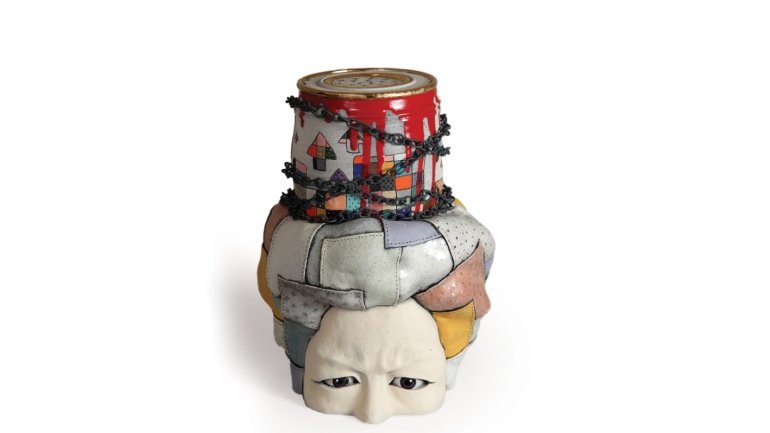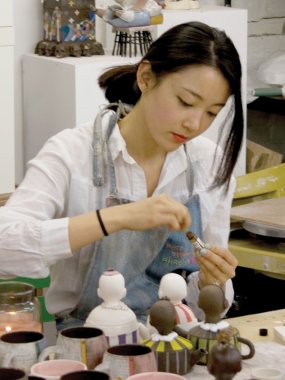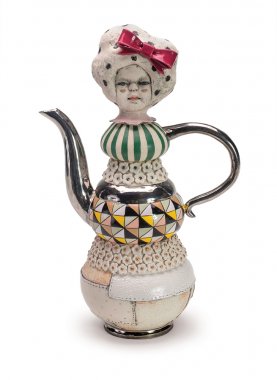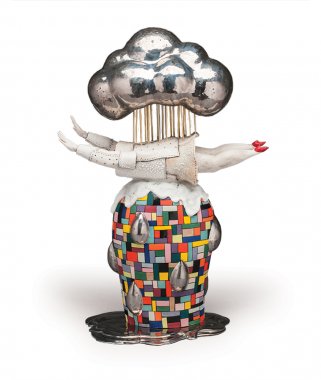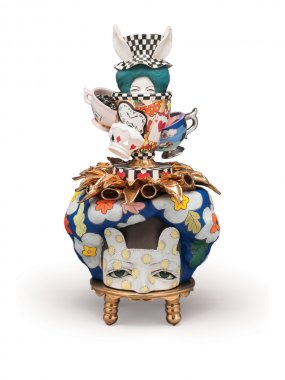Heartbreak and Hope
Heartbreak and Hope
Ahrong Kim laughs when she recalls her first contact with clay.
“I didn’t want to touch the clay – it was like touching mud. I didn’t like it at all,” says Kim, 32. She had gone to art school in her homeland of South Korea to study fashion design but quickly lost interest. To graduate, however, she had to learn every available ceramic technique.
“But then, when I learned how to throw clay, I fell in love with it and became really focused,” she says. “I can’t really explain it, except that I was very good at it right away. And because I got compliments, I started liking it even more.”
She attributes her innate talent to her grandmother. “She’s my biggest inspiration. She could make everything with her hands. She had this sewing machine, and I have these memories of seeing her make all these patterns with pieces of fabrics.”
That patchwork style, called jogakbo, uses scraps of leftover fabrics to create cloth. It’s recognizable in the sculptural work Kim makes, where the mosaics of colorful squares and rectangles might serve as a centerpiece, backdrop, or accent to the evocative worlds she creates with clay.
In her compact sculptures, generally 9 to 20 inches tall, Kim deftly juggles color, scale, and shape. In Wonderland Fountain (2017), so named because her works often conjure visions of Alice in Wonderland, a cascade of patterned objects – a polka-dotted face, tiny cups, gold leaves, and bunny ears – rises from a gold platform. Some parts are thrown, some are handbuilt, others are cast. “Most of my [components] are made separately, and I put them together at the end,” she says. “Sometimes I fire them together and the glaze acts like a glue, and sometimes I use epoxy or screws. I don’t always know if it’s going to work, so it’s exciting to see the results.”
Kim calls her more figurative work “an emotional diary,” serving a need that started when she moved to the United States in 2011 to attend graduate school at Rhode Island School of Design. “I was so excited to go to RISD, but when I got there, it wasn’t fun at all,” she says. “I had so many things to do, and the critiques were really difficult because my English wasn’t good. I wasn’t able to express myself about what I was making, and I was really frustrated. I cried a lot.” She began to channel her emotions into her sculptures, with titles such as Sadness Implosion, Untitled (I Think Everybody Hates Me), and I Am Not Angry.
“My work is often [about] a feeling of sadness and loneliness, or sometimes things like how people are fake or judgmental,” she says. But she’s happy to evoke rather than describe. “Unless someone asks me about the real story behind a piece, I’d rather [they] engage with it through their own stories.”
Since Kim earned her MFA from RISD in 2013, her career has taken off, with a long list of awards, residencies, and high-end craft shows. For the latter, she makes a line of teapots and mugs, merging function and sculpture. In August, she completed a five-year residency at the Clay Studio in Philadelphia, which she credits for opening many professional doors, and she recently relocated to Brooklyn.
“It wasn’t easy to decide to move to New York, because it’s so expensive, and I don’t really love big cities or traffic,” the artist says. “But I’m very excited for the professional opportunities and for the inspiration from being around so many working artists. If I don’t try it now, I think I’d always regret it.”
Kim is here on an artist’s visa and hopes to get a green card for permanent residency. Even though she still feels some expat alienation at times, America is home. She’s particularly fond of one significant cultural difference: “In Korea, they’re obsessed with perfection with everything, including ceramics. So while I still don’t like failures, I learned in the US that imperfection can be beautiful.”


